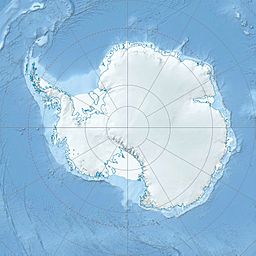Seal Nunataks facts for kids
Quick facts for kids Seal Nunataks |
|
|---|---|
| Highest point | |
| Elevation | 368 m (1,207 ft) Murdoch Nunatak |
| Geology | |
| Mountain type | volcanic vent |
The Seal Nunataks are a group of 16 rocky islands. They are called nunataks because they stick out from the Larsen Ice Shelf. This ice shelf is located east of Graham Land in the Antarctic Peninsula. Scientists believe the Seal Nunataks are separate volcanic vents. They formed over a very long time, from the Miocene to the Pleistocene periods. There are also some reports of volcanic activity in more recent times, during the Holocene period.
Contents
Discovering the Seal Nunataks
The Seal Nunataks are part of Graham Land. They used to be mostly covered by the Larsen Ice Shelf. But between 1986 and 1996, the northern part of the ice shelf broke apart. This made the nunataks, which were about 500 meters below sea level, become more visible.
A Norwegian explorer named Carl Anton Larsen discovered these islands. He found them in December 1893. He was the first to realize they were volcanoes. Larsen named them Seal Islands. Today, an Argentine base called Base Aérea Teniente Benjamín Matienzo is located in the Seal Nunataks.
Volcanoes in Antarctica
The Seal Nunataks are part of a larger area with many volcanoes in West Antarctica. This area stretches across the Antarctic Peninsula, Marie Byrd Land, and Ross Island. In the Antarctic Peninsula, the Seal Nunataks, Alexander Island, and James Ross Island are all part of this volcanic region. Alexander Island was active between 48 and 18 million years ago. James Ross Island is about 150 kilometers northeast of the Seal Nunataks.
The Seal Nunataks group has at least sixteen volcanic cones. The tallest one is Murdoch Nunatak, which is 368 meters high. These nunataks include Lindenberg Island, Larsen Nunatak, Evensen Nunatak, Dallmann, Murdoch Nunatak, Akerlundh, Bruce, Bull Nunatak, Donald, Pollux, Christensen Nunatak, Arctowski, Gray Nunatak, Oceana Nunatak, Hertha Nunatak, and Castor Nunatak.
These rocky islands are ridges that are between 1 and 6 kilometers long. They are often covered with scree (loose rocks). Sometimes, you can see features from their volcanic past. For example, Christensen Nunatak might have a crater. Castor, Christensen, and Hertha are the only volcanoes that show signs of erupting above ice. They have lava flows. The other nunataks are made of hyaloclastite and pillow lavas. These form when lava erupts under ice or water. The volcanoes seem to line up in rows that go from northwest to southeast.
What the Seal Nunataks are Made Of
The Seal Nunataks are mostly made of a type of rock called basalt. This basalt often contains minerals like clinopyroxene, olivine, and plagioclase. Scientists have also found small pieces of rock called xenoliths in the Seal Nunataks. These xenoliths are made of lherzolite and spinel.
The way these rocks are made suggests that the lava came from deep inside the Earth's mantle. It seems the lava changed only a little bit as it moved towards the surface.
When the Volcanoes Erupted
Scientists have used a method called potassium-argon dating to find out how old the rocks are. They found ages from 4 million years ago to more recent times. Rocks that formed under ice, like pillow lavas, are usually about 1.5 million years old. Rocks that formed above ice, from subaerial eruptions, are about 700,000 years old. The youngest rocks found are on Donald and Gray Nunataks, which are less than 200,000 years old. Some rocks on the nunataks show that glaciers once covered them.
Captain Larsen, who discovered the islands, reported seeing volcanic activity on Christensen Nunatak and Lindenberg Island. However, it's not completely clear if these reports are accurate. Fumaroles (vents that release steam and gases) have been seen on Christensen, Dallman, and Murdoch Nunataks. There were also reports of eruptions on Dallman and Murdoch in 1982. These events might have included new lava flows and the creation of a pyroclastic cone (a cone-shaped hill made of volcanic ash and rocks).
See also
 In Spanish: Nunataks Foca para niños
In Spanish: Nunataks Foca para niños


